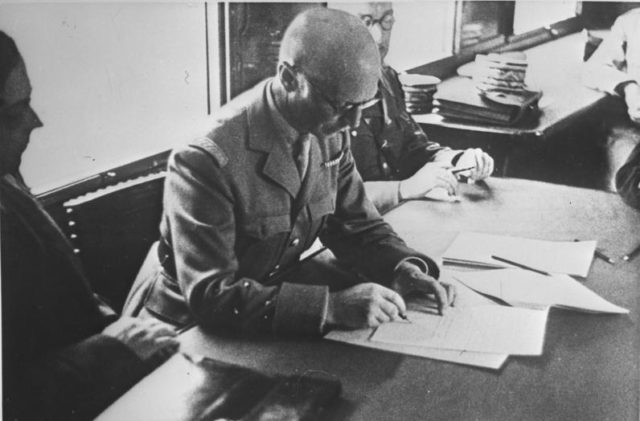How did the German Wehrmacht manage to defeat the combined armies of France and Britain in 1940 given France was militarily superior in many respects?
The quick defeat is customarily ascribed to a mixture of the French High Command’s effort to refight the systematic battle of the First World War, against Germany’s acceptance of modern mobile, all–arms combat. While philosophical reasons played a large role in the outcome, something much more basic and human might have been the decisive factor: intelligent, fearless and sometimes brutal leadership when the forces of both nations met.
Up until the collapse of the French armed forces in 1940, they had been known as – including by the Germans – the military leaders of Europe.
Under the Treaty of Versailles imposed on Berlin in the first ten years after the war, Germany was restricted to no more than 100,000 soldiers, one hundred ‘search and rescue’ aircraft and no armored vehicles.
France in comparison rebuilt its armed forces following World War 1, and in the early part of the 1930’s started a major modernization effort, motorizing many of its infantry divisions and beginning to assemble armored units.

Concentrating on stopping another German invasion into French territory, Paris had formed a military policy giving importance to the defensive. The purpose was to first weaken any incursion, and when the enemy had been adequately subdued, to then move to offense.
In line with this philosophy, they constructed the Maginot Line of guard posts and other heavily defended emplacements between her western neighbor and France.
Senior officers of the High Command were sure their ideas and defensive preparations would have a positive outcome against any German attack, especially Gen. Charles Huntziger, commander of the Second French Army.
Less than two months before the surprise invasion by Germany, Parliamentary Army Committee member Pierre-Charles Taittinger led a parliamentary group to inspect the defenses in Sedan that fell under Huntziger’s command.
Taittinger fatefully reported that too much emphasis was placed on the shielding effect of the Ardennes woods and the Meuse River to protect Sedan. He said too much importance was attached to the natural obstacles and their defenses were too simplistic. General Huntziger ignored Taittinger’s warning, telling the Army’s chief comptroller the Germans too were afraid of attacking. On May 9, less than one day before the invasion, Huntziger told his troops that German preparedness was only an exercise, and the Germans would not take the added risk of confronting 27 Belgian divisions.
Before May 1940, the combined British and French forces had close to 1,000 more tanks than the Germans, French tanks were better armored and had powerful main guns. France was also renowned as the global leader in artillery and had a distinctive advantage over Germany in this respect.
The French planned to quickly move large numbers of infantry divisions into Belgium to counter the Wehrmacht as far forward as possible. They believed the mountainous and forested terrain in the Ardennes prohibited using armor, and, along with the Maginot defenses, they felt that light forces could shield that portion of the front. The Germans elected to do the opposite of was anticipated.
Germany sent in large numbers of mechanized divisions to Belgium and the Netherlands to have the Franco-British alliance believe its intelligence was correct and that the major attack would come from the north.

In the meantime, the main German attack came further south, in the Ardennes, with the majority of their Panzer divisions. A main objective of German armor was the penetration of the Meuse River at Sedan, just inside the French border. Lt. Col. Hermann Balck, who distinguished himself later as among the most talented battle leaders, led the tip of the attack.
Balck was charged with leading the First Rifle Regiment across the Meuse River near Sedan, The National Interest reported.
His breakthrough across the river was the result of systematic preparation, demanding field training, and, at the point of attack, brutal, brave leadership that motivated men to succeed at tasks they thought outside their ability.
